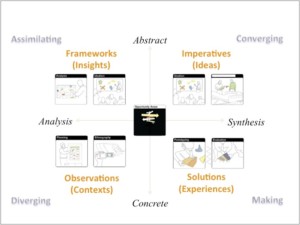Teaching Design Thinking and Doing
ME290KA (2 units)
Innovation Through Design Thinking
Faculty:
Prof. Alice Agogino, 415 Sutardja Dai Hall (CITRIS), x2-6450, agogino@berkeley.edu. She sometimes posts updates on her whereabout and activities on Twitter: http://twitter.com/agogino
Alan Van Pelt, Design strategy consultant, (650) 248-3937, apvanpelt@yahoo.com
Course Objectives:
Designed for professionally-oriented graduate students, this course explores key concepts in design inovation based on the human-centered design an approach called “design thinking”. Topics cover include human-centered design research, analysis of research to develop design principles, creativity techniques, user needs framing and strategic business modeling. This course will introduce students to the tools and practices of innovation, deep customer insight, and design thinking in real world applications. Design has become an increasingly powerful force in the last decade. What began as a focus on styling and aesthetics has led to sophisticated methods and processes for creatively tackling a wide variety of problems. More than ever, designers are called upon to place human needs at the center of their design engagement. As a result, Design Thinking has become a powerful approach to addressing issues at micro and macro levels, ranging from problem-solving complex social and cultural problems, to innovating in startups and Fortune 500 companies alike.
This course will introduce students to the tools, practices, modes of thinking, and theory of Design Thinking, with an emphasis on practical application. Upon completion of the course, students will understand the concepts and key tenants of design thinking as an approach to problem solving, and will be able to leverage their learnings for their own projects and careers. By the end of the semester, students will be able to:
- Explain the methods, processes, and key tenets of design thinking.
- Investigate problems, develop research methods, and synthesize results to form solutions.
- Develop a deeper understanding of users and their interactions with the designed environment.
- Understand that, in addition to the creation of innovative objects and places, design thinking can be applied to the development of new processes, services, interactions, and collaborations.
- Recognize the interdisciplinary practice of various design professions and the value of design thinking as a means of innovative problem solving across disciplines.
- Build a rigorous and elegant argument for design projects.
Desired Course Outcomes:
The primary goal is to provide students with a set of innovation skills that will allow them to flourish in a climate of complex problem solving and design challenges. Students will learn to participate in and lead innovation and creativity in collaborative settings. Students should be able to communicate and apply the skills mastered to real world design problems.
Topics Covered:
Design thinking models and tenets, qualitative research methods, problem finding and framing, analysis and synthesis of research, reflective thinking, ideation and creativity techniques, experimentation and rapid prototyping, collaborative skills and technologies, concept testing, iterative design, and identifying and communicating unique points of view.
Class/Laboratory Schedule:
There will be a lot of doing in the class sessions to develop facility with the Design Thinking tools that students can apply to their own research projects and beyond.
- 4 hours per week for first half of Fall semester.
- The three-hour sessions on Mondays will engage students in deep dives with material covered in the readings and lecture.
- The one-hour Friday session will expose students to designers from industry and provide practical hands-on training in topics such as sketching, journaling, creating design portfolios, prototyping, creativity tools, etc.
We define design thinking as an iterative divergent-convergent (synthesis-analysis) human-centered design questioning approach to design that requires both abstract thinking and active experimentation. The Kolb Learning Style framework is used to illustrate the iterative cycles of design thinking over these axes. Here design thinking starts with inspiration from insights gained from observations of human values and needs (moving from concrete observations, to analyses and then to abstract insights). Ideation is the process of generating and refining design concepts. Realization can take the form of proof of concept prototypes, simulations, physical testing or business models or plans. Design teams need to collectively develop facility in all four quadrants of divergent thinking using design research methods (e.g., empathic design, observations, interviewing), assimilating data and abstracting insights, converging on compelling imperatives and developing innovative design solutions.
Topics covered are: Design thinking models and tenets, qualitative research methods, problem finding and framing, analysis and synthesis of research, reflective thinking, ideation and creativity techniques, experimentation and rapid prototyping, collaborative skills and technologies, concept testing, iterative design, and identifying and communicating unique points of view.
Information and Syllabi:
- Fall 2014 Syllabus. M 1:00-4:00 pm; F 1:00-2:00 pm: Cal Design Lab (494 Wurster Hall).
- Fall 2013 Syllabus. M 1:00-4:00 pm; F 1:00-2:00 pm: Cal Design Lab (494 Wurster Hall). The final was a tournament sponsored by Larson-Juhl.
Last updated: 20 March 2016



